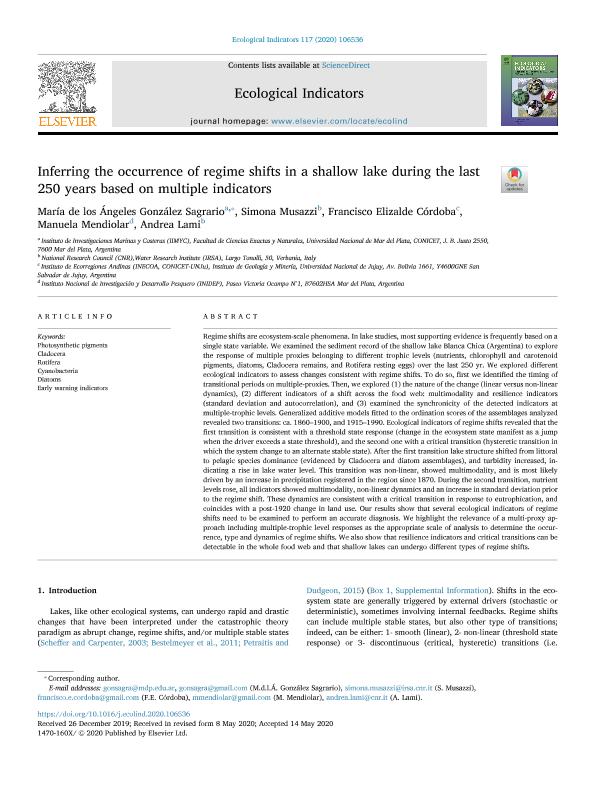Artículo
Inferring the occurrence of regime shifts in a shallow lake during the last 250 years based on multiple indicators
Gonzalez Sagrario, Maria de Los Angeles ; Musazzi, Simona; Cordoba, Francisco Elizalde
; Musazzi, Simona; Cordoba, Francisco Elizalde ; Mendiolar, Manuela; Lami, Andrea
; Mendiolar, Manuela; Lami, Andrea
 ; Musazzi, Simona; Cordoba, Francisco Elizalde
; Musazzi, Simona; Cordoba, Francisco Elizalde ; Mendiolar, Manuela; Lami, Andrea
; Mendiolar, Manuela; Lami, Andrea
Fecha de publicación:
05/2020
Editorial:
Elsevier Science
Revista:
Ecological Indicators
ISSN:
1470-160X
Idioma:
Inglés
Tipo de recurso:
Artículo publicado
Clasificación temática:
Resumen
Regime shifts are ecosystem-scale phenomena. In lake studies, most supporting evidence is frequently based on a single state variable. We examined the sediment record of the shallow lake Blanca Chica (Argentina) to explore the response of multiple proxies belonging to different trophic levels (nutrients, chlorophyll and carotenoid pigments, diatoms, Cladocera remains, and Rotifera resting eggs) over the last 250 yr. We explored different ecological indicators to assess changes consistent with regime shifts. To do so, first we identified the timing of transitional periods on multiple-proxies. Then, we explored (1) the nature of the change (linear versus non-linear dynamics), (2) different indicators of a shift across the food web: multimodality and resilience indicators (standard deviation and autocorrelation), and (3) examined the synchronicity of the detected indicators at multiple-trophic levels. Generalized additive models fitted to the ordination scores of the assemblages analyzed revealed two transitions: ca. 1860–1900, and 1915–1990. Ecological indicators of regime shifts revealed that the first transition is consistent with a threshold state response (change in the ecosystem state manifest as a jump when the driver exceeds a state threshold), and the second one with a critical transition (hysteretic transition in which the system change to an alternate stable state). After the first transition lake structure shifted from littoral to pelagic species dominance (evidenced by Cladocera and diatom assemblages), and turbidity increased, indicating a rise in lake water level. This transition was non-linear, showed multimodality, and is most likely driven by an increase in precipitation registered in the region since 1870. During the second transition, nutrient levels rose, all indicators showed multimodality, non-linear dynamics and an increase in standard deviation prior to the regime shift. These dynamics are consistent with a critical transition in response to eutrophication, and coincides with a post-1920 change in land use. Our results show that several ecological indicators of regime shifts need to be examined to perform an accurate diagnosis. We highlight the relevance of a multi-proxy approach including multiple-trophic level responses as the appropriate scale of analysis to determine the occurrence, type and dynamics of regime shifts. We also show that resilience indicators and critical transitions can be detectable in the whole food web and that shallow lakes can undergo different types of regime shifts.
Archivos asociados
Licencia
Identificadores
Colecciones
Articulos(INECOA)
Articulos de INSTITUTO DE ECORREGIONES ANDINAS
Articulos de INSTITUTO DE ECORREGIONES ANDINAS
Citación
Gonzalez Sagrario, Maria de Los Angeles; Musazzi, Simona; Cordoba, Francisco Elizalde; Mendiolar, Manuela; Lami, Andrea; Inferring the occurrence of regime shifts in a shallow lake during the last 250 years based on multiple indicators; Elsevier Science; Ecological Indicators; 117; 106536; 5-2020; 1-16
Compartir
Altmétricas



